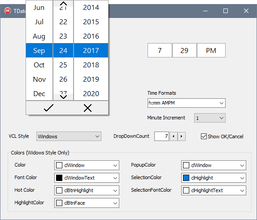

- C builder starter how to#
- C builder starter software#
- C builder starter code#
- C builder starter mac#
C builder starter how to#
As a programmer, you decide if, why, when, and how to use this control. Users do not see nor do they use a timer as a control.

The message is something to the effect of "I have counted the number of lapses you asked me to count".Īs opposed to the time that controls your computer, a timer is partly but greatly under your control. To work, every lapse of period, the control sends a message to the operating system. Although you don’t usually need to worry about how Objective-C “works,” it’s possible to interact directly with this runtime system, as described by Objective-C Runtime Programming Guide and Objective-C Runtime Reference.A timer is a non-spatial object that uses recurring lapses of time in a computer or in your application. In addition to the compiler, the Objective-C language uses a runtime system to enable its dynamic and object-oriented features.
C builder starter code#
If you are unable to take advantage of ARC, or need to convert or maintain legacy code that manages an object’s memory manually, you should read Advanced Memory Management Programming Guide. For the most part, the Automatic Reference Counting (ARC) feature of the compiler takes care of this for you. Objective-C apps use reference counting to determine the lifetime of objects. For information on language feature availability, see Objective-C Feature Availability Index. For more information about Xcode, see Xcode Overview. The content in this document applies to Xcode 4.4 or later and assumes you are targeting either OS X v10.7 or later, or iOS 5 or later. If you’re not familiar with these concepts, you should read the relevant chapters in Concepts in Objective-C Programming. Reasonable coverage is given to general object-oriented programming principles, particularly as they apply in the context of Objective-C, but it is assumed that you have at least a minimal familiarity with basic object-oriented concepts. If you have knowledge of another higher-level programming language, such as Ruby or Python, you should be able to follow the content. Xcode is the IDE used to build apps for iOS and OS X you’ll use it to write your code, design your app's user interface, test your application, and debug any problems.Īlthough it’s preferable to have some familiarity with C or one of the C-based languages such as Java or C#, this document does include inline examples of basic C language features such as flow control statements.

Additionally, you should become familiar with Xcode before trying to follow the exercises at the end of most chapters in this document.
C builder starter mac#
If you are new to OS X or iOS development, you should read through Start Developing iOS Apps Today (Retired) or Start Developing Mac Apps Today before reading this document, to get a general overview of the application development process for iOS and OS X. You’ll also provide a class implementation, which includes the executable code for each method declared in the interface. Method declarations indicate the messages that an object can receive, and include information about the parameters required whenever the method is called. This interface includes the public properties to encapsulate relevant data, along with a list of methods. If you’re writing your own class, start by providing a description of the class that details the intended public interface to instances of the class. Those objects are instances of Objective-C classes, some of which are provided for you by Cocoa or Cocoa Touch and some of which you’ll write yourself. When building apps for OS X or iOS, you’ll spend most of your time working with objects. An App Is Built from a Network of Objects Although the framework classes are separate from the language, their use is tightly wound into coding with Objective-C and many language-level features rely on behavior offered by these classes. You’ll learn how to create your own classes describing custom objects and see how to work with some of the framework classes provided by Cocoa and Cocoa Touch. This document introduces the Objective-C language and offers extensive examples of its use. It also adds language-level support for object graph management and object literals while providing dynamic typing and binding, deferring many responsibilities until runtime. Objective-C inherits the syntax, primitive types, and flow control statements of C and adds syntax for defining classes and methods. It’s a superset of the C programming language and provides object-oriented capabilities and a dynamic runtime.
C builder starter software#
Objective-C is the primary programming language you use when writing software for OS X and iOS.


 0 kommentar(er)
0 kommentar(er)
